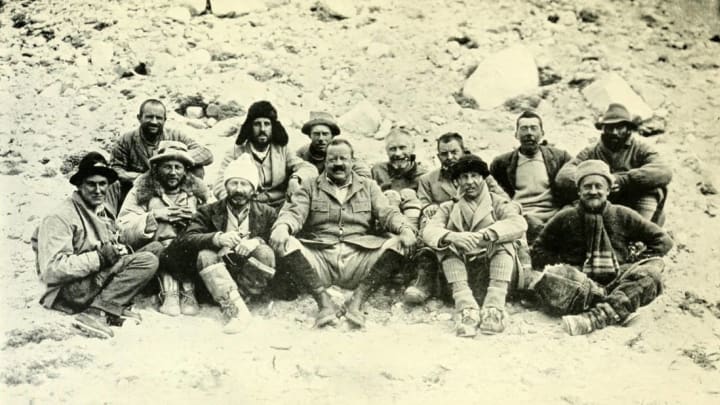Among the many events that will be on display at the Tokyo Olympic Games is sport climbing, which is making its debut this year. Participants will be competing in speed competitions, bouldering (climbing as many routes as possible in 4 minutes), and lead climbing (climbing as high as they can in 6 minutes).
While sport climbing is new, the Olympics actually have an intriguing history with mountaineering. But at the turn of the 20th century, it was so treacherous that many of those recognized for their achievements had to be awarded their medals posthumously.
This macabre footnote in Olympic history was made possible when the Games recognized the sport of alpinism, or alpine climbing, as an official activity beginning in 1894—though it would take another 30 years for the first medal to be awarded. Alpinism is characterized by ascending quickly up mountain routes. While participants weren’t focused on medals, achievements in mountaineering could lead to a measure of Olympic glory in the form of an Olympic Alpine Prize, a gold medal bestowed on those who were attempting to conquer then-unreachable summits.
The Mount Everest Precedent

The first medal for alpinism was handed out on February 5, 1924, at the first Winter Olympic Games in Chamonix, France, when the International Olympic Committee (IOC) awarded medals to each of the 13 members (12 British, one Australian) of the 1922 Mount Everest expedition. The trip was led by General Charles Granville Bruce and his second-in-command, Lieutenant Colonel Edward Strutt, along with noted climber George Mallory.
It was the first time anyone had made a determined and focused effort to reach the summit, and the ambition received global attention. But the expedition was treacherous in the extreme. Absent amenities like advanced winter jackets, proper ropes, or precedent, they fell short of the top; after three attempts, an avalanche befell the team. Medals were later given to the seven Sherpas from Darjeeling, India, who died during the expedition as a result of the catastrophe. (An eighth medal went to a Nepalese soldier, Tejbir Bura, who also perished during the attempt.)
The Sherpas were named as follows:
Antarge Sherpa
Lhakpa Sherpa
Narbu Sherpa
Pasang Sherpa
Pembra Sherpa
Sange Sherpa
Temba Sherpa
Sherpas have traditionally had the most formidable task in scaling mountains like Everest. They carry heavy equipment and fix ropes for climbers while making sure that each climber in their care remains healthy and safe.
Team member Dr. Arthur Wakefield recalled seeing the aftermath. "When I looked back the whole wall was white and there was no string of ascending climbers,” he wrote in a letter to his wife. “At first I thought all had been wiped off by the avalanche. But as I kept looking, the fuzz of snow settled down, and I gradually made out most of the figures still on the slope.”
Absolute Heroism

Adding to this unique honor was the fact that it was the first and only time a medal had been awarded to a multinational team, as the Olympics typically sees nations competing against each other. IOC chairman Pierre de Coubertin said the medalists had displayed “absolute heroism on behalf of all the nations of the world.”
Lt. Strutt was present to collect the medals on behalf of the team and vowed to reach the Everest summit with one of them in hand. But this never happened. The first two people to reach the summit of Everest were Tenzing Norgay (also known as Sherpa Tenzing) and Edmund Hillary in 1953.
In fact, George Mallory didn’t live to see his medal, either. Not long after Strutt accepted the awards on the team’s behalf, Mallory went missing during another attempt to summit Everest in 1924. His body wasn’t found until 1999.
Second Thoughts
More medals in the Olympian Alpinism Prize for still-living climbers followed, including brothers Franz and Tony Schmidt for scaling the Matterhorn’s North Face in the 1932 Los Angeles Games and husband-and-wife team Günter and Hettie Dyhrenfurth for a Himalayan exploration in 1934, which was recognized during the 1936 Games in Berlin. (The Dyhrenfurths were German and Jewish but became Swiss citizens, though that didn't prevent the Germans from largely ignoring their accomplishment.)
By that time, IOC members were having second thoughts about the mortality rate of alpinism medal recipients. They began to voice concern that handing out medals might encourage more people to take life-threatening risks. Only ascents sanctioned by national alpine clubs would be permitted.
It didn’t much matter. World War II halted Olympic competition and alpinism ceased to be part of the Olympics in 1946—but that hasn’t been the end of the Games and mountaineering. In 1987, Reinhold Messner and Jerzy Kukuczka were awarded silver medals for climbing 14 of the world's 8000-meter peaks, though Messner refused the award.
The sacrifices and steely constitution of those 1922 alpinism participants have not been forgotten, though. In 2012, climber Kenton Cool—who had ascended Everest nine times—took an Olympic gold medal to the summit of Mount Everest in honor of Strutt, who had vowed to return to the fabled peak with the team’s prize in his hand. The medal belonged to Charles Wakefield, grandson of Dr. Arthur Wakefield, one of the few recipients of the most hazardous Olympic award in history. Though not direct descendants of mountaineering's champions, today's sport climbing athletes are ascending a route paved by these brave few.
